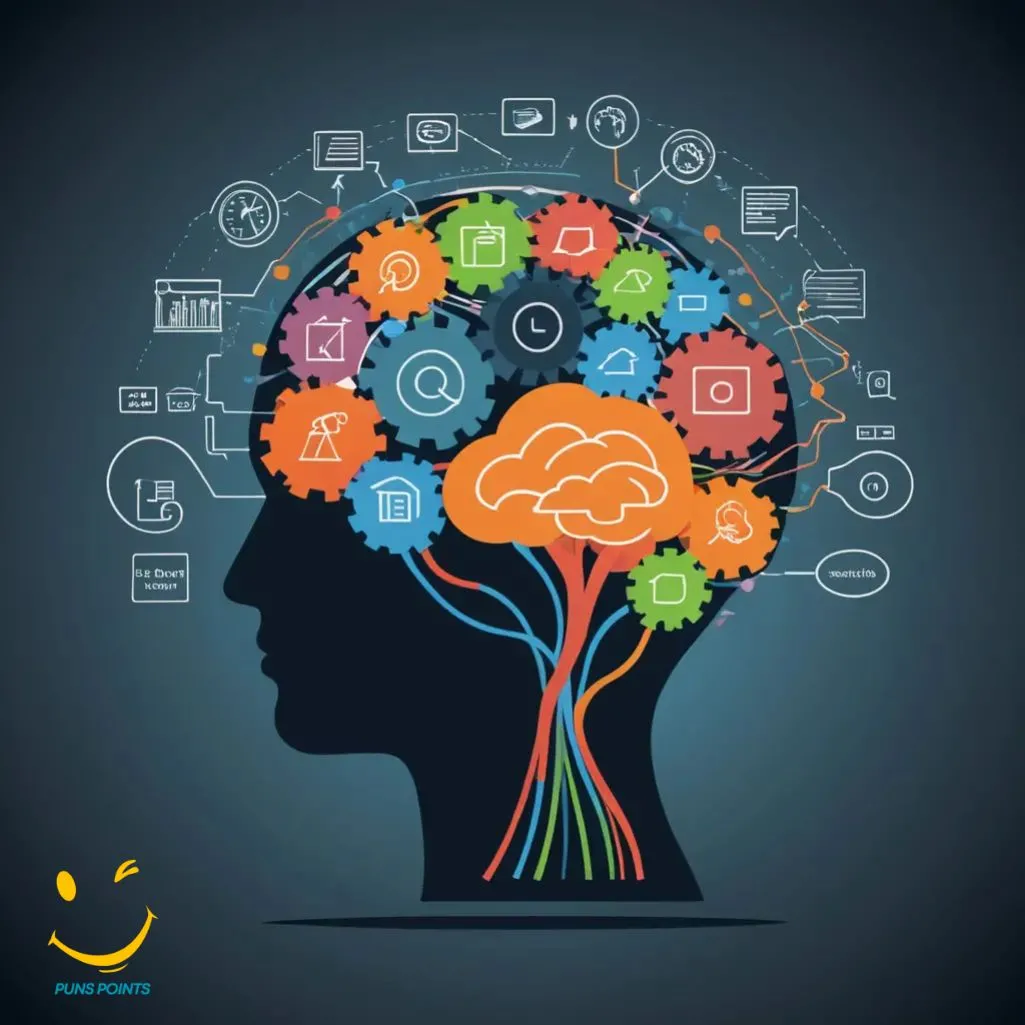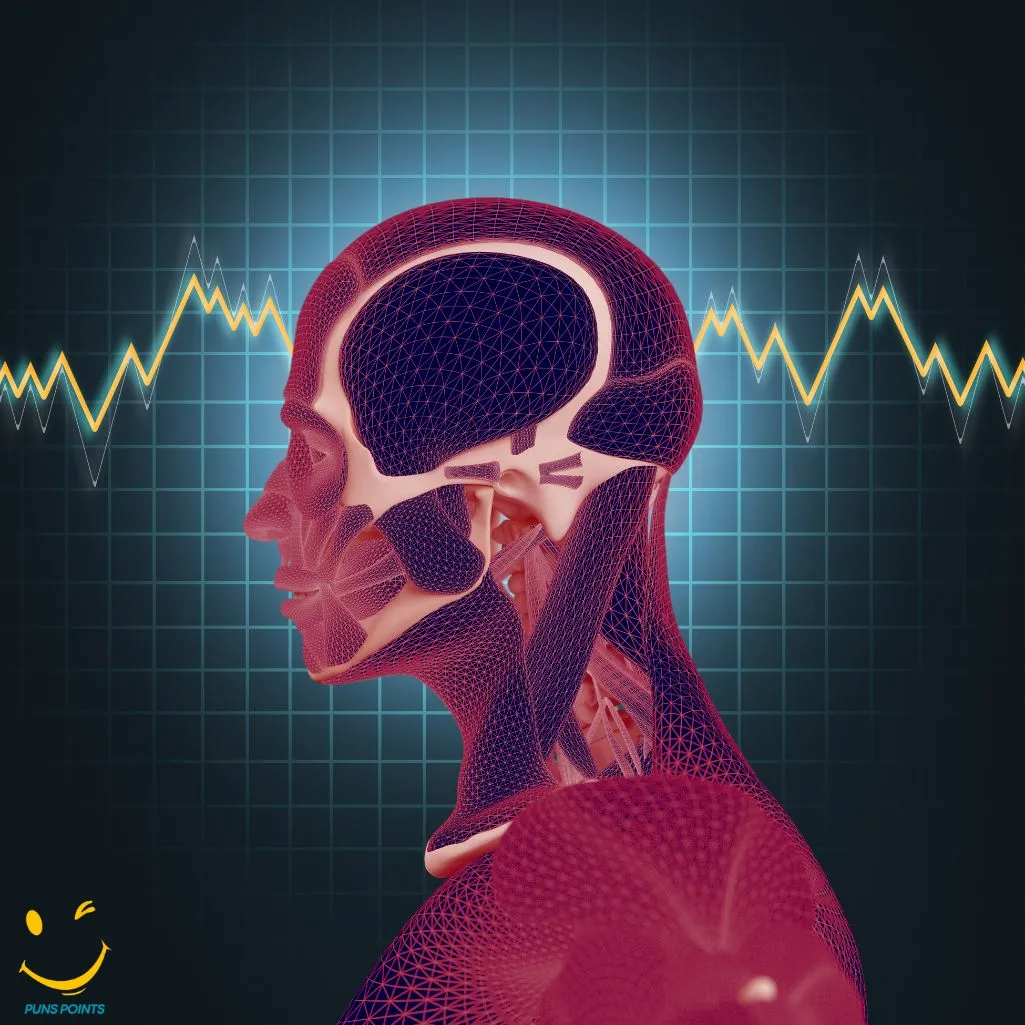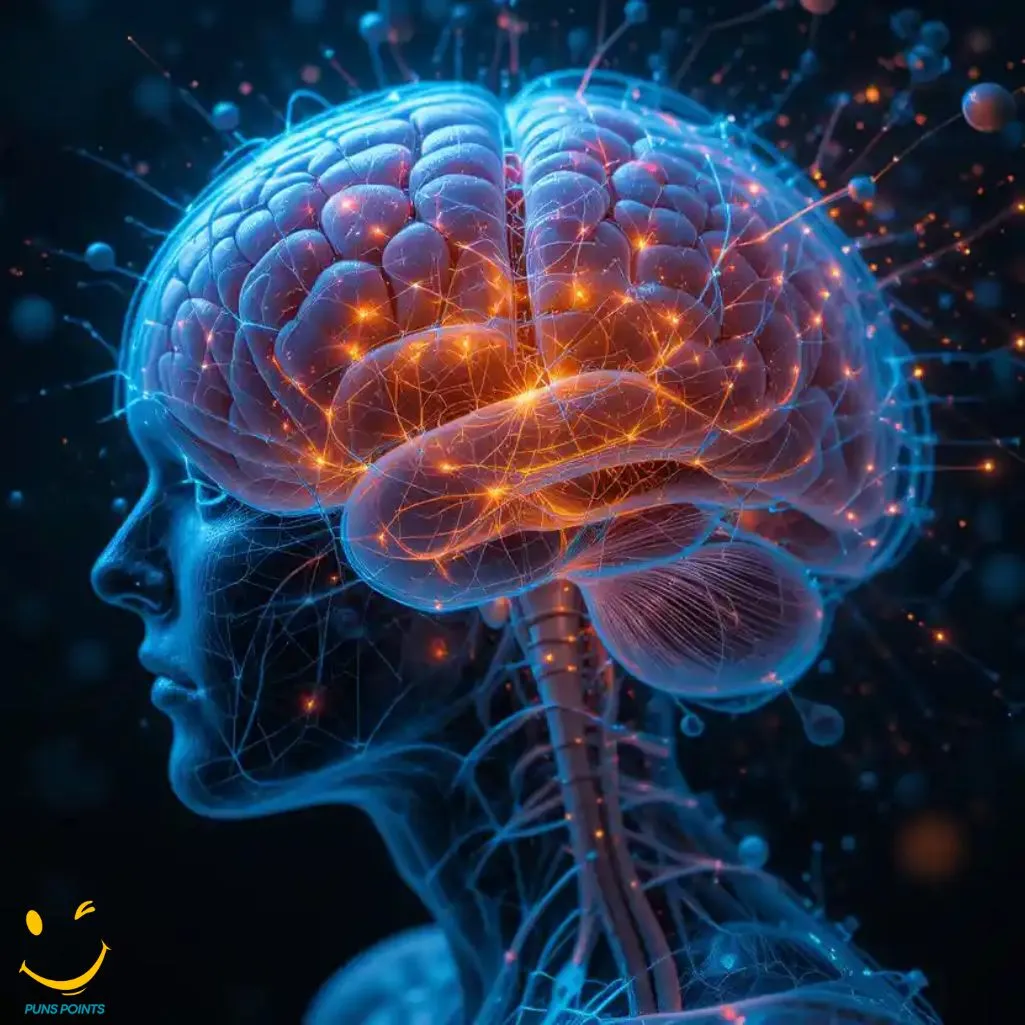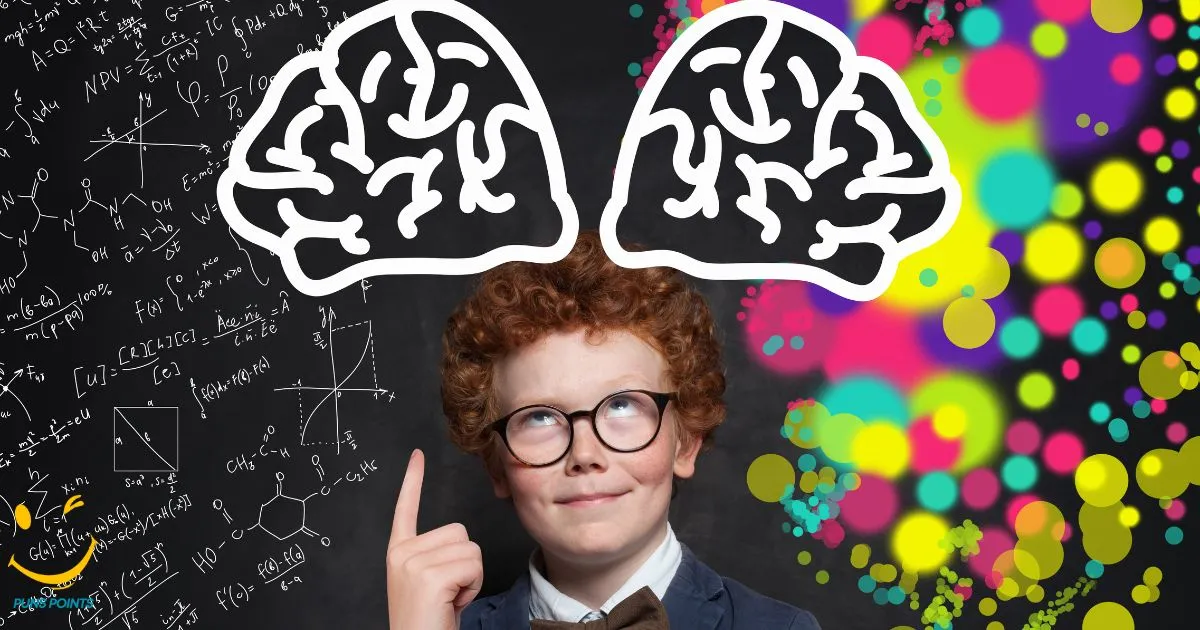“The brain’s ability to process humor, especially through puns, is a complex dance between cognition and emotion, making us laugh in unexpected ways.”
Humor and laughter do more than just brighten our day they trigger fascinating reactions in the brain. When we laugh, our brains release feel-good chemicals, like endorphins and dopamine, which promote a sense of happiness and relaxation.
But what’s happening beneath the surface? In this exploration, we’ll dive into the science of how our brains process humor, how laughter impacts our emotional and physical well-being, and why these reactions are essential for social bonding and overall health. Get ready to discover how something as simple as a laugh can have profound effects on our brain and body.
Humor is an essential part of human communication and culture, and one of the most fascinating types of humor is the pun. Puns, or plays on words, are forms of wit that rely on double meanings or similar-sounding words to create humor.
They can be lighthearted, witty, or even challenging, but what’s particularly interesting is how the brain processes these clever linguistic twists. In this blog post, we will dive into how our brain processes humor through puns, exploring cognitive mechanisms, individual differences, and the overall impact of puns on language and communication.
Neural Correlates of Punning
- Brain regions involved in humor processing – The brain’s response to humor, especially puns, is influenced by areas like the frontal lobe, temporal lobes, and the prefrontal cortex.
- Activation of the left hemisphere – The left hemisphere is responsible for processing the language and structure of puns.
- Right hemisphere engagement – The right hemisphere adds depth to the pun by providing creative and emotional context.
- Dual processing in pun recognition – Puns often involve both a linguistic interpretation (left brain) and a creative one (right brain).
- The role of the prefrontal cortex – This part of the brain is responsible for higher cognitive functions, such as planning and decision-making, which plays a role in processing puns.
- The temporal lobes – These regions help us understand the meaning behind a pun, especially with regards to ambiguity and wordplay.
- Frontal lobe activity – The frontal lobe allows for cognitive flexibility when we switch between multiple meanings of words in a pun.
- The role of memory – Recognizing puns requires the brain to access previous knowledge or multiple meanings stored in memory.
- Reward system activation – A pun that succeeds in its humor can activate the brain’s reward system, releasing dopamine.
- Processing ambiguity – The brain deals with the ambiguity inherent in puns by managing conflicting meanings or sounds.
- Language comprehension centers – The Wernicke’s area, responsible for language comprehension, is activated when interpreting puns.
- “Puns often create a brief moment of confusion, and the humor resolves it when understood.”
- The impact of surprise – The brain reacts to the unexpected nature of a pun, which contributes to the element of surprise in humor.
- Word association in pun processing – The brain relies on rapid word associations, which are key in punning.
- Multisensory processing – Puns can involve multiple senses when they are spoken aloud or encountered in writing.
- Puns and emotional processing – The emotional impact of a pun is processed through the amygdala and other emotional centers in the brain.
- Puns and creativity – A pun can activate regions linked to creative thinking, particularly the right brain.
- Processing multiple meanings – Puns are often built on words with dual meanings, which the brain processes at the same time.
- Humor’s neurological benefits – Laughter in response to puns can enhance brain function and improve mood.
- The role of attention – Paying attention to both meanings of a pun requires focus, which is managed by the brain’s attentional networks.
- Social cognition and puns – The brain processes puns in a social context, as humor often requires shared knowledge or experiences.
- Pun appreciation and humor – The sense of humor involved in punning is tied to brain functions that help us appreciate the witty or clever nature of wordplay.

- Motor cortex involvement – Smiling or laughing at a pun involves the motor cortex to trigger facial expressions.
- Pun recognition and cognitive flexibility – The ability to switch between different meanings in a pun shows the brain’s adaptability.
- Neural plasticity and humor – Repeated exposure to puns can help the brain adapt, strengthening connections related to humor processing.
- Pun-induced laughter and brain waves – Laughter from puns influences brain waves, showing a shift in brain activity that correlates with relaxation and enjoyment.
- Language comprehension and humor appreciation – The more fluent we are in language, the more effectively we process puns.
- Pun processing and decision-making – Evaluating a pun requires the brain to make a decision about its humor and appropriateness.
- Interaction with language networks – Puns activate language networks in ways that are distinct from straightforward communication.
- Pun processing as a cognitive workout – Understanding puns can be mentally challenging, offering cognitive benefits akin to exercise.
Individual Differences in Punning Ability
- Personality influences punning ability – People with a humorous personality tend to be better at understanding or creating puns.
- Cognitive flexibility and punning – Individuals with high cognitive flexibility can easily switch between different meanings, making them more adept at puns.
- Cultural background – A person’s culture can influence how they perceive and create puns, as language and humor differ across cultures.
- Age-related differences – Younger individuals may be more creative with puns, while older adults may have more experience with them.
- Education and punning – Higher education levels may correlate with a greater ability to understand complex puns.
- Humor styles – People who enjoy wordplay, sarcasm, and wit are often better at creating or appreciating puns.
- Attention span – A longer attention span helps in recognizing and understanding puns, which require focus on multiple meanings.
- “People who are highly proficient in a language can better grasp puns that rely on nuanced language knowledge.”
- Creativity levels – Highly creative individuals are often quicker to generate puns or appreciate their cleverness.
- “Frequent social interactions expose people to more puns, which helps them develop better punning skills.”
- Verbal intelligence – Individuals with higher verbal intelligence can process and create puns more effortlessly.
- Memory for words – A strong memory for words helps people understand the multiple meanings and nuances involved in puns.
- Mood and humor – A positive mood can enhance a person’s ability to both create and appreciate puns.
- Familiarity with puns – Those who have a regular exposure to puns in media or conversation often have a better ability to understand them.
- Visual-spatial skills – Some studies suggest people with strong visual-spatial reasoning may also perform well in pun recognition.
- Response to incongruity – How an individual processes incongruity affects their ability to understand puns, as puns often rely on an initial confusion.
- Linguistic diversity – People who speak multiple languages might have a broader understanding of puns due to knowledge of homophones or homonyms.
- Time of day – People are often more adept at understanding puns when they are alert, typically earlier in the day.
- Social context of humor – People with a greater social awareness may be better at detecting puns in conversation.
- Cognitive load – Individuals under cognitive load may have difficulty processing the multiple meanings inherent in puns.

- Humor preference – People who prefer wordplay or clever humor are more likely to create or enjoy puns.
- Confidence in humor – Confident individuals may be more likely to create puns, as they are less concerned about whether their wordplay lands.
- Genetic factors – Studies suggest that some aspects of humor ability could be influenced by genetic factors.
- Influence of humor training – People who actively engage in activities that require humor, like comedy writing, may be better at creating puns.
- Social norms awareness – People who are more attuned to social norms may create puns that align better with group expectations.
- Cultural awareness – Awareness of cultural references can influence how people create or understand puns.
- Verbal processing speed – People who can process language quickly are likely to recognize or create puns more easily.
- Experience with word games – Playing word games like Scrabble or crossword puzzles can sharpen punning skills.
- Emotional intelligence – People with high emotional intelligence may understand the social context of a pun better.
- Sensitivity to ambiguity – Some individuals are more sensitive to ambiguity, which is key in recognizing the humor in puns.
The Humor of Grammar and Clever Wordplay Explored
Impact of Puns on Language Learning
- Enhanced word retention – Puns can make words easier to remember by associating them with humor.
- Understanding language structure – Puns help learners understand the structure and nuances of a language.
- Creative thinking in language use – Puns encourage creative thinking and flexibility with language.
- Building vocabulary – Engaging with puns helps learners expand their vocabulary through wordplay.
- Increased motivation to learn – Learning through humor, like puns, increases engagement and motivation.
- Contextual learning – Puns teach learners to understand the context in which words and phrases are used.
- Cultural immersion – Puns often rely on cultural references, helping learners understand the culture behind a language.
- Improving pronunciation – Puns with homophones can help learners practice pronunciation.
- Facilitating language fluency – Exposure to puns can improve fluency by encouraging fluid, spontaneous use of language.
- Developing critical thinking – Learners use critical thinking to understand the multiple meanings in puns.
- Engagement in conversation – Puns can make conversations more engaging, encouraging learners to speak more often.
- Humor as a mnemonic device – Puns serve as memory aids, making it easier to recall language rules or vocabulary.
- Expanding idiomatic knowledge – Puns expose learners to idiomatic phrases, which are often used in everyday language.
- Improving listening skills – Understanding puns in conversation sharpens listening comprehension.
- Cross-language learning – Learning puns in different languages can facilitate understanding between languages.
- Increased lexical access – Puns help learners access different meanings of words more rapidly.
- Building self-confidence – Successfully understanding or creating puns boosts confidence in language learning.
- Contextual humor understanding – Puns teach learners how to navigate the different contexts where humor is appropriate.
- Reducing language anxiety – Humor, like puns, helps reduce anxiety and fosters a relaxed learning environment.
- Understanding homophones – Many puns rely on homophones, which helps learners grasp this key aspect of language.
- Cognitive flexibility in language use – Puns challenge learners to switch between meanings quickly.
- Social language skills – Puns help learners develop social skills through humor in conversations.
- Improving reading comprehension – Puns often rely on context and reading comprehension, reinforcing these skills.
- Learning through exposure – Hearing or reading puns in natural settings exposes learners to authentic language use.
- Encouraging language creativity – Learners can experiment with language and create their own puns.
- Recognizing wordplay – Understanding the mechanics of puns helps learners recognize and appreciate wordplay in the language.
- Critical listening skills – Listening for puns improves learners’ ability to discern meaning from speech.

- Engaging learners in grammar rules – Puns often rely on grammatical structure, reinforcing grammar lessons.
- Puns as a cultural tool – Understanding puns helps learners navigate cultural references in language.
- Building rapport in language exchanges – Using puns in language exchanges can build rapport and strengthen communication.
The Structure of Puns
- Wordplay and double meanings – Puns often rely on double meanings or multiple interpretations of a word.
- Homophones and homonyms – Puns frequently use words that sound the same but have different meanings.
- Syntax manipulation – The structure of a sentence is sometimes altered to accommodate the pun.
- Ambiguity – Puns thrive on ambiguity, as they exploit the various interpretations of a word.
- Contextual clues – The context in which a pun is used is key to understanding its humor.
- Phonetic manipulation – Some puns work by manipulating the sound of words to create humor.
- Word formation – Puns may involve creating new words or altering existing ones for comedic effect.
- Incongruity – Puns often set up an expectation that is defied by the punchline.
- Unexpected conclusions – The punchline of a pun often leads to an unexpected conclusion that makes it humorous.
- Play on definitions – Puns work by leveraging multiple definitions of a single word.
- Anticipation – A pun often builds anticipation in the listener before delivering the twist.
- Juxtaposition – Puns often place two different meanings or interpretations side by side.
- Metaphorical puns – Some puns work by using a metaphor to make the punchline clearer.
- Clever twist – A well-constructed pun often delivers a clever twist that catches the listener off guard.
- Short wordplay – Simple puns often use very few words to achieve humor.
- Contextual relevance – For a pun to be successful, the context must be relevant to the audience.
- Temporal puns – Some puns rely on time-related wordplay.
- Syllabic manipulation – Puns may change the syllables of a word to create humor.
- Analogies – Some puns create humor by drawing comparisons between unrelated things.
- Surprise punchlines – A good pun often leads to a punchline that surprises the listener.
- Direct and indirect humor – Puns can be either direct (clear wordplay) or indirect (subtle manipulation of language).
- Contradiction – Some puns use contradiction to create humor through the unexpected.
- Linguistic creativity – Puns often showcase the speaker’s ability to manipulate language creatively.
- Timing – The effectiveness of a pun is often determined by its timing.
- Play on sounds – Sound-based puns, such as those involving rhyming or alliteration, are common.
- Visual puns – Puns can be visual, playing with how words look or their graphical presentation.
- Semantic shift – Puns can involve a shift in meaning that changes the interpretation of the word.
- Absurdity – Many puns work because of the absurdity that they present.
- Pun escalation – Sometimes, puns build on each other, escalating the humor with each twist.
- Breaking expectations – Ultimately, the structure of a pun often breaks expectations in a way that triggers laughter.
The Cognitive Processes Involved
- Simultaneous processing – The brain processes multiple meanings of words in real-time when encountering a pun.
- Quick cognitive switches – Switching between interpretations is a key cognitive process when understanding puns.
- The brain quickly resolves the incongruity when it understands a pun.
- Memory retrieval – Understanding puns often involves recalling previous knowledge or experiences related to the wordplay.
- Engaging pattern recognition – Puns require recognizing patterns in language that trigger humor.
- Semantic priming – The brain uses previously learned meanings of words to interpret puns.
- “The punchline of the pun violates expectations, causing cognitive dissonance.”
- Cognitive flexibility – The ability to understand and appreciate puns depends on the brain’s cognitive flexibility.
- Humor recognition – The brain’s ability to recognize humor through puns is a distinct cognitive process.
- Emotion and humor – Emotional responses to puns engage areas of the brain related to enjoyment and laughter.

- Neurocognitive processing – Processing puns involves both linguistic and emotional responses.
- Automatic and controlled processes – Recognizing and understanding puns can involve both automatic and conscious cognitive processes.
- Abstract thinking – Puns often require abstract thinking to connect unrelated ideas or meanings.
- Attention shifts – The brain shifts attention rapidly to process the different meanings in a pun.
- Contextual awareness – Cognitive awareness of context helps the brain determine which meaning of a word is intended.
- Mental flexibility – Flexibility allows the brain to switch between different interpretations of a word in a pun.
- Effortless processing – Experienced individuals process puns more effortlessly than beginners.
- Meaning integration – Integrating multiple meanings of a word involves advanced cognitive functions.
- Thought restructuring – Restructuring thoughts is needed to grasp the humor behind complex puns.
- Social cues interpretation – Recognizing puns in a social setting requires interpreting non-verbal social cues.
- Pun creation – Creating puns involves divergent thinking and cognitive creativity.
- Language processing speed – The speed at which the brain processes puns depends on familiarity and practice.
- Emotion-regulation systems – The emotional response to puns involves systems that regulate laughter and enjoyment.
- Pun detection – Detecting puns requires the brain to distinguish between regular language and humor.
- Selective attention – Focusing on the pun while ignoring irrelevant information requires selective attention.
- Neural synchronization – Understanding puns requires synchronization of various brain regions involved in language and emotion.
- Mental simulation – The brain uses mental simulation to anticipate the punchline of a pun.

- Word association network – The brain activates word association networks to recognize wordplay.
- Cognitive error correction – The brain quickly corrects errors in interpretation when a pun is resolved.
- “The overall social or conversational context often guides the cognitive process behind punning.”
Final Take
Humor through puns offers a glimpse into how our brains process language and creativity. Whether it’s the surprise twist of a clever pun or the rapid switching of meanings, our cognitive functions work in fascinating ways to make sense of and enjoy wordplay.
Engaging with puns helps improve our understanding of language structure, encourages creativity, and strengthens our cognitive abilities. As humor aids in learning, it also serves as a powerful tool in building rapport and enriching communication. Understanding the cognitive processes behind puns reveals how intertwined humor and language truly are, making puns a unique window into our brain’s abilities.
Key Insights About
Why do puns make us laugh?
Puns make us laugh because they exploit multiple meanings of words, creating an unexpected twist that defies our expectations.
How do puns help with language learning?
Puns help language learners by increasing engagement, teaching word meanings, and improving cognitive flexibility.
What cognitive processes are involved in understanding puns?
Understanding puns involves simultaneous processing, cognitive flexibility, and incongruity resolution, among other mental processes.
Can puns improve creativity?
Yes, puns encourage creative thinking and problem-solving by playing with language in novel ways.
Are puns effective for social communication?
Puns can enhance social communication by creating a fun, engaging atmosphere and building rapport through humor.

Hi! I’m Jane Austen, a master of timeless puns with a modern twist, blending wit and laughter into every line!

